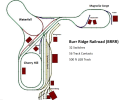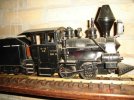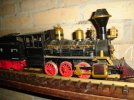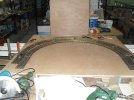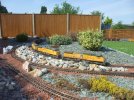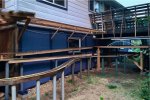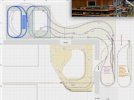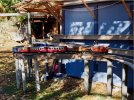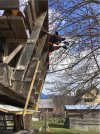On your layout, do you keep a minimum curve radius?
And what is the reason? Here are some reasons I can think of. There are probably others I didn't think of.
- These big curves look better to me
- These small curves are all I can fit in
- My stock will derail on anything smaller
- I have steep inclines, so I need gentle curves
- For my theme, tight curves are prototypical
Thanks.
Hi Jasper.
My first garden railway was originally laid at 2'6" radius curves. At the time, we has mainly electric rats which ran fine, and my only steam loco was a mamod SL1. Mamods were not the most sedate locos, and often derailed, when the time came to rebuild the railway following a house move for work away for 4 years, followed by moving back to our house which we had rented out, we rebuilt the railway elsewhere in the garden. This allowed us to mainly use 8' radius curves, with some 5' in sidings. The railway ran very well and looked lovely, ( in our opinion anyway).
Following what I hope will be our last house move, we now have a much smaller garden, so we now have what is basically an end to end railway with a return ballon loop. The loop is sadly only 2'8" radius, which looks quite tight so we are going to build a cutting to hide the tight curve, the train will just disappear, and reappear from a bridge about 5'4" away and run back down to the terminus, where locos are run around their train, which for me, adds to the fun of running our railway.
I am involved with our local model engineering society, where I am a part of the group who are building a raised garden railway through an existing rockery. Yes that is hard work, I spent several days cutting through a large rock to form a cutting, but it is looking good as far as we have got to date. This is planned to be 6' minimum radius, with wider radius where we can. Hopefully this will result in a railway which natural looking, and will help to keep visitors entertained on open days.
I also am connected with a mainly steam powered exhibition layout group, where we use 5'6" radius as the norm on the running line, with some smaller radii in sidings, down to about 4'6" as trains are usually running much slower while shunting. The 4'6" does occasionally get used on the running line for small exhibitions, but it does work for 0-4-0 or some 0-6-0 locos.
I appreciate that in a modern garden space can be tight, and 2' radius is the only option, but unless you are modelling Statfold Barn, or something similar, larger radius is best especially for live steam. Small electric locos will usually cope better with tight curves, so if that is what you are planning you may be fine. I have seen a lovely exhibition layout with less than a foot radius but it was a very nice industrial style layout, very small diesel, pulling one or two wagons at a time.
Anyway to sum up decide what sort of railway you want to run. What style of trains. Generally small battery or track power 0-4-0 locos pulling short trains you should get away with 2' curves. Live steam will be easier and look nicer with larger radius in my opinion.
Note these are my thoughts, others may think otherwise, and I would not say anyone's railway is wrong. As I said above we had to change from lovely wide curves to a very tight one on a part of our current railway. You have to work within the size you can allocate to the railway, taking in to account other family members use of the garden.
Regards,
David


